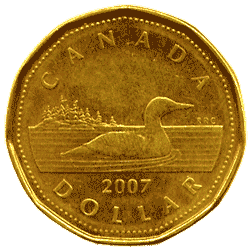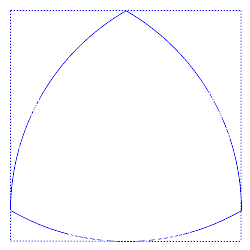Whatever Strikes my Fancy.

When Loonies first came out in 1987 I was working for the Royal Bank of Canada and got to see them before they were officially released to the public. And having been a coin-collector, I examined the new coin with great interest. When I first saw one I was a little puzzled as to why they had eleven sides rather than, say, ten or twelve. I also noticed that the sides were not completely flat, but are in fact very subtle arcs (notice how the rim is thinner right at the corners than it is at the centre of the bevel.) I assumed the slight rounding was for because one would expect a sharp angle to round off with wear anyway, so why waste the metal. The best explanation I ever got for the eleven sides was one for each province and one for the territories, which was a bit unsatisfactory since there were two territories at the time (now there are three) so twelve would seem to have been a more reasonable number.
Today, while off on a mathematical tangent, I found out that, as it happens, there is a very good reason for this odd number. The Loonie is not an eleven-sided polygon at all, the shape is an eleven-sided curve of constant width. The technical specifications for the Loonie from the Royal Canadian Mint state that the Loonie has a diameter of 26.5 mm.

A normal flat-sided polygon cannot have a constant width, but the Loonie does. If you set two bars precisely 26.5 mm apart, the Loonie would fit exactly between them no matter what the orientation. If this wasn't true, imagine how hard it would be to tool a vending machine to accept the coin!
The animation to the right is a "Reuleaux triangle" which is another curve of constant width, in this case with three sides, which makes it easier to see how it works. You can see by the rotating shape that the Reuleaux triangle touches all four of the parallel sides of the square no matter what its orientation. The Loonie works works the exact same way, but with eleven sides. And it is eleven because this sort of thing can only be done based on polygons with an odd number of sides.
The kind of clever geometry is not unique to the Loonie. When Britain switched to decimal coinage, the new 50 pence coin introduced in 1969 featured (and still does) a seven-sided curve of constant width. And the British 20 pence coin, introduced in 1982 — five years before the Loonie — is also a seven-sided curve of constant width.
So, restricted to odd numbers, one side for each province and one for the territories was as good as it could get. It is impossible to make a coin with twelve sides that would reliably work in coin-operated machinery. Theoretically, now that Nunavut has come along, the number of sides could be changed to thirteen to give all the territories a fare shake, but I expect there are enough triskadekaphobes to make that a bad choice.
And, because I am a massive geek, I have updated the Wikipedia page about the Loonie to include this information.
Oringinal post: http://mbarrick.livejournal.com/886742.html